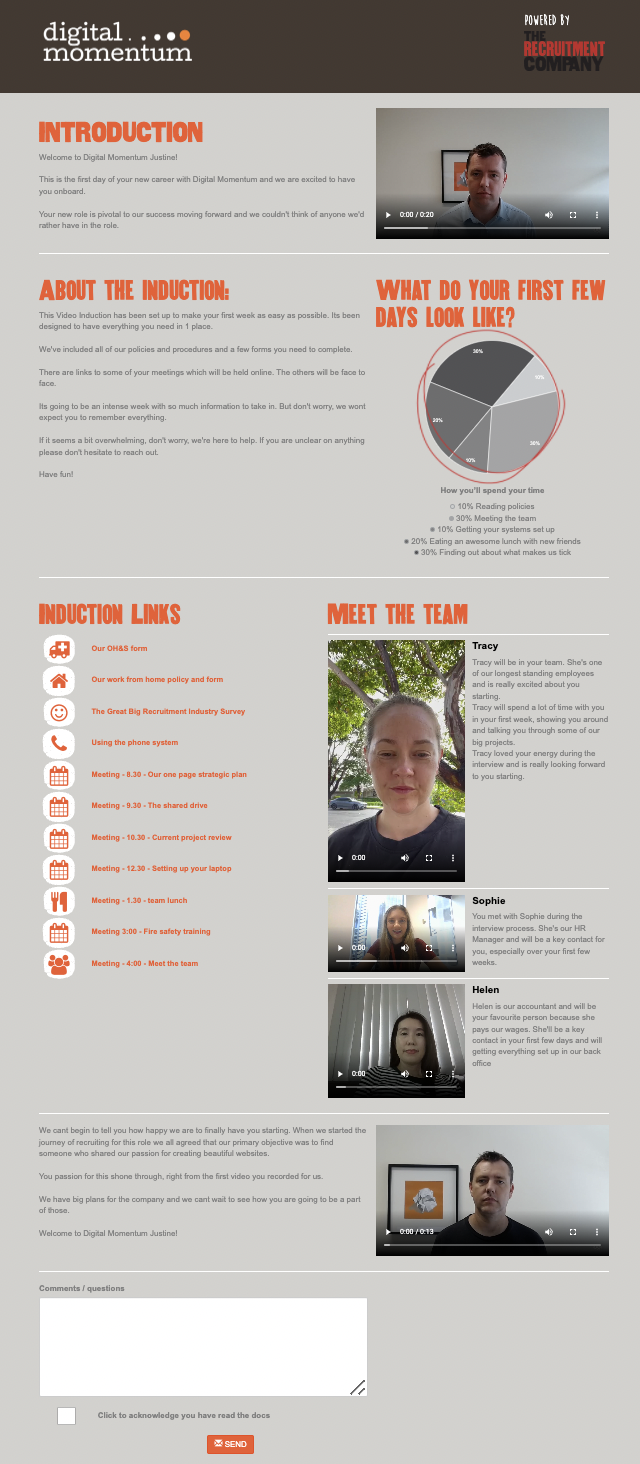Submitted on Tue 08 Mar 2022
We’ve all been there. You wake up, excited about your new job, nervous because you haven’t heard from anyone since they sent the employment contract, but excited none the less.
You arrive, the person at the front desk doesn’t know who you are, but that’s OK, why would they? You sit in reception for about 15 minutes after the time you were told to turn up and then a manager walks out in a bit of a fluster.
“Sorry,” they say, “things are CRAZY around here today.”
You get sat at a desk and given a pile of forms to fill in and a generic handbook to read. Your desk is pretty grubby. They’ll, “find you a proper one later in the week,” they tell you. Your PC isn’t set up, but apparently, “IT will be over soon to get you set up.”
Your first day is dull. You meet a few people who seem very busy and you get the feeling that you are somewhat of an inconvenience to them.
By the end of week 1, your PC is finally up and running and you have most, but not all, of the passwords you need to do your job. You’ve met a few of your team. HR have done the OH&S tour, you’ve met the office larrikins who say things like, “welcome to the madhouse!!” and “you don’t have to be mad to work here, but it helps!!” and you smile politely. You’ve been told, in a hushed whisper, to avoid this person and that person, and you’ve been telling your friends, (and yourself), that it will get better once you get settled.
3 months in, very little that was promised during your interview process has been delivered. You think you’re doing OK but you’re not sure. You were pretty much thrown in the deep end and left to your own devices. That’s OK, you’re good at what you do.
Then, out of the blue, you get a call from a recruiter. “Are you currently open to hearing about other opportunities?”
You sit and think for a bit, then reply, “Maybe…”
Research shows that 69% of employees are more likely to still be with your organisation after 3 years if they had a “great” onboarding experience. Even if it’s not “great” but is “structured” then your chances of keeping the employee for 3 years increases by 50%.
When you put this in the context of the financial, time and brand costs associated with hiring and rehiring then it’s a significant consideration.
So why does a poor onboarding experience impact people so much? Surely, it’s just the first week being a bit chaotic? Surely newbies can understand that you’re busy?
The problem, I believe, is all about company values. Company values are not what you say they are, they are what you show they are.
Take new born ducklings. Ducklings latch onto the first thing they see and think it’s their mother. This is called ‘imprinting’. Similarly, new employees latch onto the first values they see displayed and assume that these are the values of the organisation. They also ‘imprint’.
In those first few moments of employment you, whether you intend to or not, you show what it is that you do, and don’t, value. Unfortunately, if you aren’t careful then, by having a poor onboarding experience, you can show your new employee that one of the things you don’t value, is them.
Furthermore, people join organisations because their personal values match those of the business. If someone has joined your business because you told them you had values A, B, C and when they arrive you show values X, Y, Z then there is instant misalignment.
But it doesn’t have to be this way. It is simple and cheap to fix it. It just needs a bit of thought.

Now imagine if…
You’ve arrived at the allotted time. Someone from HR called you a week before to give you a run down on what to expect in your first week. They also asked you a bit about dietary requirements and what sort of wine you liked. Your new manager called you yesterday to say how much they were looking forward to you starting. You get to the office, the person in reception greets you by your name as you walk in. You are taken straight in and everyone knows who you are and says hi. You feel quite comfortable because you’d been sent a video of the team saying “Hi” a few days before.
You are taken to your desk where you find a welcome pack including some branded merchandise, some amazing cupcakes to share with your new teammates and a nice, personalised letter from the CEO welcoming you to the company. Your PC is set up, your phone extension is set up with your name, you have all your passwords, and everything is ready to go.
After a brief chit chat you sit down with someone for your first meeting. You are prepared for it because you were sent a detailed agenda a week before which outlines all of the meetings you will be having, who you will be having them with and what you’ll be covering. The first meeting is intense, it dives straight into important, challenging topics and surprises you with transparency.
During the first week you cover a whole range of engaging topics which give you insight into the company, its goals, your role and your team. You see where the company is going, and you see how your role plays a part in getting there. You know how you are measured and what success looks like. You’ve met with senior management and by the end of day 5 you feel like you are part of the business.
The additional cost of example 2 is about $78* (a box of cupcakes, a branded notebook and a cap with a logo on it) but the additional benefit is a saving of approximately $180,000**
In this crude example (admittedly with some gross generalisations, major assumptions and very dodgy maths) that’s a return on investment of over 230,000%. What other situation do you know where you could invest $78 and get a 69% chance of a return of 230,000% over 3 years? So, from an investment perspective, creating a good induction is like ground floor investment in Bitcoin, Apple and facebook rolled into one.
So why do so few organisations choose not to invest in a good induction and robust onboarding process? Why do so many new employees end up disillusioned with their new employer from day 1? Why are inductions always the part of the recruitment process that get the least amount of attention?
The answer falls into one, or a combination, of:
- The company doesn’t care – “They’ll figure it out”
- The company values other tasks over an induction – “We’re just too busy”
- The company isn’t aware of the negative impact a sloppy induction has – “It’s what everyone else does.”
So here’s a basic, 3 step guide to wowing your new employee.
1. Have a system

Build a system that works and have someone accountable for setting it up. This system should be in the form of a checklist or workflow. There are some great workflow tools out there. The system should incorporate scheduled calls and emails to go out between offer and start date. These should include templates that can easily be personalised.
The system should include content written for meetings that will be scheduled within the first week. These can be written so that anyone can run the meeting or to be presented by the same person each time. But they should be set out so that each new employee has a consistent introduction to the company. They should be written in an engaging way and should cover all topics that should be covered during the induction; everything from the OH&S tour, through to the history of the business, the values of the business, how meetings work, how things are measured etc. Each of these should be a different ‘module’ that can easily be distributed to whoever is going to deliver it.
Make one person within the business accountable for ensuring the system is implemented for each and every new employee. Train this person on the importance of getting it right every time. Give them the authority to push back on people who disrupt the flow of the system, even those more senior than them.
The system should include a checklist of things to be completed and set up before the start date.
2. Plan the first day / week / month
Book in meetings with team members delivering the modules. Book out the new employee’s diary for the whole first week with content. Mix up the location so it stays fresh (use meeting rooms, their desk, cafes: a change in scenery stops it becoming monotonous).
Set up follow up meetings in the weeks and months after induction to make sure that things that were promised are done and to allow for feedback and improvement to the system.
3. Make the first day amazing
Start day 1 with something unexpected. Don’t start with the boring, “Here’s the HR manual, let me know when you’ve finished reading it.” Start with, “Here’s the CEO to talk you through her strategy for the next 12 months,” or, “Here’s how your performance in your role impacts the business reaching it goals”. Start with something big, bold and surprising. Imprint intense, transparent and collaborative rather than petty, predictable and complacent.
If you have a day in the week that is full of meetings and nobody is available, then don’t start the employee on that day. Start them on a day when people can focus on it. If Mondays are meeting days, then always start new employees on Tuesdays. Build that into your system.
Be fanatical about making everything 100% ready by the time the employee walks through the door. Treat it with the importance you would give to an investment with a potential 230,000% return.
Organise a team lunch on the first day - make it personal to them (you should know, before they start, of any dietary requirements) and make sure their close team members come along. Show them that they are important to the team, push back on those who are “too busy” to go.
Make sure the day starts on a high and also ends on a high. Keep something exciting for their last session of the day eg talk through their bonus or advancement potential. Then send them off with a nice bottle of wine or a cake to take home. You want them to get home, exhausted but happy, and sit with their family to talk about what an unexpectedly amazing day they’d had.
And what will you get in return?
- An employee who knows your values
- An employee who is 69% more likely to still be there in 3 years
- An employee who talks you up to all of their ex-colleagues
- An employee who lives and breathes your values and who is an advocate of the business both internally and externally
- An employee who knows your business inside out within 1 week and is therefore able to perform their job better.
All for the investment of a few cupcakes, a bit of planning and a genuine desire to make an amazing first impression.
If you are looking to engage a recruitment agency to help hire amazing people for your awesome company and you’d like to start with a chat, then call us today on (02) 8346 6700 and speak to one of our recruiters or send us an email to [email protected]
The Recruitment Company – Making people enjoy the recruitment experience again
Specialist Sydney Employment Agency within Information Technology, Project Services, IT Infrastructure, Software Development, SAP, Data and Analytics, Devops, Cloud and the Public Sector.
* I totally made this number up, in reality I have no idea how much a box of cupcakes, a branded notebook and a cap with a logo on it cost and to be honest you could probably think of something better than this. But you get my point.
** Cost of having to replace someone can equal 150% of their salary https://builtin.com/recruiting/cost-of-turnover#2 Based on an average IT salary of $120k
As an aside, if you're looking for an induction workflow tool, why not check out the Video Induction Toolkit Its a flexible, branded workflow tool that can be built around your systems, documents and processes. Its a simple way to add a personal touch to your induction.
View a sample here
View the entire Video Recruitment Toolkit here
For a mere $200 per month you could have your own video induction toolkit. Email [email protected] for more information
"I found having all the meetings, links and files in one place much easier than juggling between calendar, outlook and teams specially during the first week when amount of information is coming from all directions scrambles my brain."
"The Video Induction is fantastic and has totally changed the way we engage with our new starters during their induction. It’s easy to navigate and the functionality is brilliant. We don’t have an internal HR system so our induction schedules were on an excel spreadsheet, which was pretty boring. With this dashboard our new starters have access to all their meetings, onboarding forms, training along with videos from our MD, and other members of the team giving them a warm welcome."
"Just wanted to say how much I love working with this product. As we continue to work as a remote company, this dashboard is perfect for us and I’m hearing great things about it from my new team members."
"I thought the video induction was fantastic. The ability for staff to upload videos to welcome me was a really great feature, and I also liked how it was a central “one stop shop” to links to policies, team meetings, key contacts etc. The fact that it was personalised for me was a big drawcard.
Throughout my first week I was able to keep in open and refer back to it to see my scheduled meetings so it was very useful tool and one that is especially useful in a work from home environment."



























